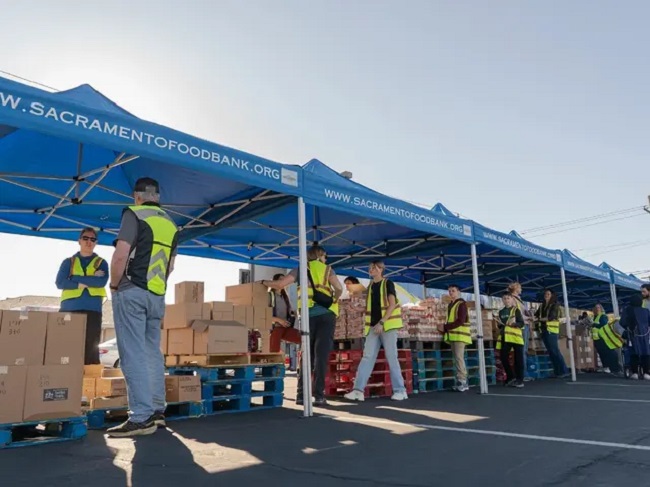SACRAMENTO, Calif. — Five years after the COVID-19 pandemic sent shockwaves through the economy and pushed millions of Californians into food insecurity, demand at food banks remains alarmingly high — and aid is now drying up.
At the Sacramento Food Bank and Family Services, the number of people served each month has more than doubled since before the pandemic. The organization now supports 310,000 clients each month, according to spokesperson Kevin Buffalino. But just as the need remains elevated, key federal and state funding streams are being cut or frozen.
Earlier this month, the U.S. Department of Agriculture suspended hundreds of millions of dollars in bonus food orders that had been promised to food banks across the country, including 330 truckloads bound for California. Eleven of those trucks — carrying about 400,000 pounds of food — were headed to Sacramento.
“There’s no indication if or when those orders will come,” Buffalino said. “It’s a huge blow, especially at a time when the need has not gone down.”
The Los Angeles Regional Food Bank is facing an even larger loss, with 90 truckloads now in limbo.
The now-frozen bonus orders were part of a program launched under the Biden administration last December. It aimed to supplement regular USDA food deliveries with additional support for food banks, tribal governments, and underserved communities. However, the funding freeze comes amid an administration shift under President Donald Trump, who has vowed to cut federal spending and reassess social programs he deems inefficient or ideologically misaligned.
Further compounding the crisis, the USDA on March 7 abruptly terminated a separate Biden-era grant initiative that had awarded more than $80 million to California food banks and tribal groups since 2022. The program enabled organizations to purchase food from local farmers and producers, bolstering regional food systems and delivering fresh food to struggling families. Another $47 million in expected grant funding has now been canceled.
No clear explanation has been provided for the cut. The USDA did not respond to multiple requests for comment.
At the state level, food banks are bracing for additional cuts as California grapples with a significant budget shortfall. Governor Gavin Newsom’s proposed budget for the upcoming fiscal year slashes funding for CalFood — a state program that allows food banks to purchase food from local sources — from $60 million to just $8 million.
These combined cuts threaten the very foundation of food distribution in communities like Sacramento, where the food bank spends $3.5 million annually on food purchases. Nearly 40% of the food the bank distributes comes from purchases supported by federal or state funds.
“We’re facing a confluence of funding losses that could significantly limit our ability to serve the community,” Buffalino said.
For many residents, the Sacramento Food Bank is a critical lifeline. Among them is Antoinette Turner, 61, who began visiting the food bank last year after a persistent foot condition forced her into early retirement from her hospital job. On a recent Tuesday morning, she joined hundreds of others — including veterans, retirees, and refugee families — at a food distribution site in the Arden-Arcade area of Sacramento.
Volunteers handed out staples like canned soup, rice, peanut butter, beans, and frozen turkey. Turner said the support has been essential.
“It’d be sad if they had to cut back,” she said. “It makes my life easier.”
Across the state, food banks are calling on lawmakers to maintain current levels of support — but they face stiff competition for limited resources. California receives over $314 billion in annual federal funding for social services, including food aid, health care, and housing. Another $81 billion comes through federal grants and contracts with nonprofits and private entities.
Now, with the Trump administration eyeing sweeping federal cuts and the state budget under pressure, leaders in Sacramento are grappling with tough decisions.
“These are Sophie’s choices,” said Assemblymember Gregg Hart, a Democrat from Santa Barbara who chairs a key budget subcommittee. “Every single thing that we could talk about has a federal funding connection that’s in jeopardy, and the state just doesn’t have the money to backfill it.”
Meanwhile, the need for food assistance is not slowing. If anything, advocates say, it’s growing.
“People are still struggling to recover from the economic impacts of the pandemic,” Buffalino said. “We’ve seen inflation, rising housing costs, and reduced public assistance — and now we’re being asked to do more with less.”

